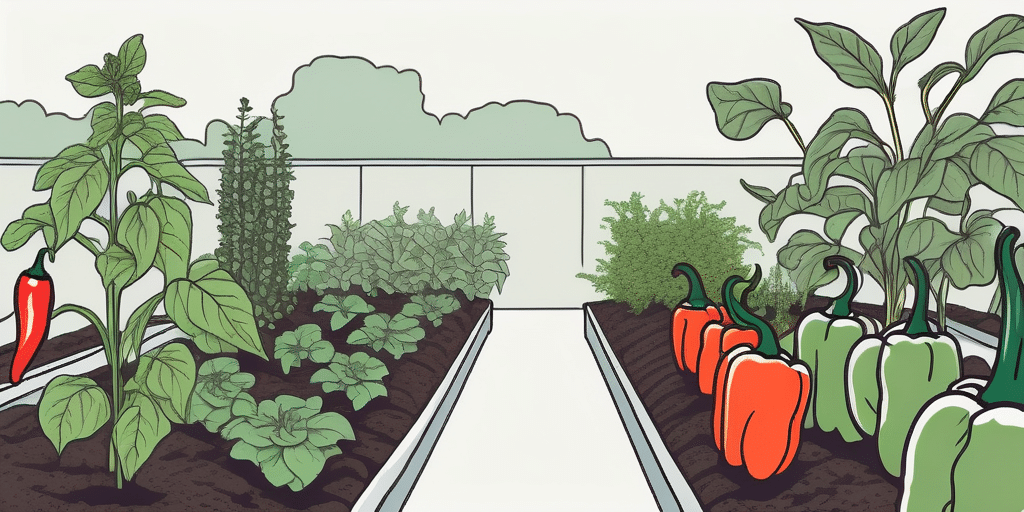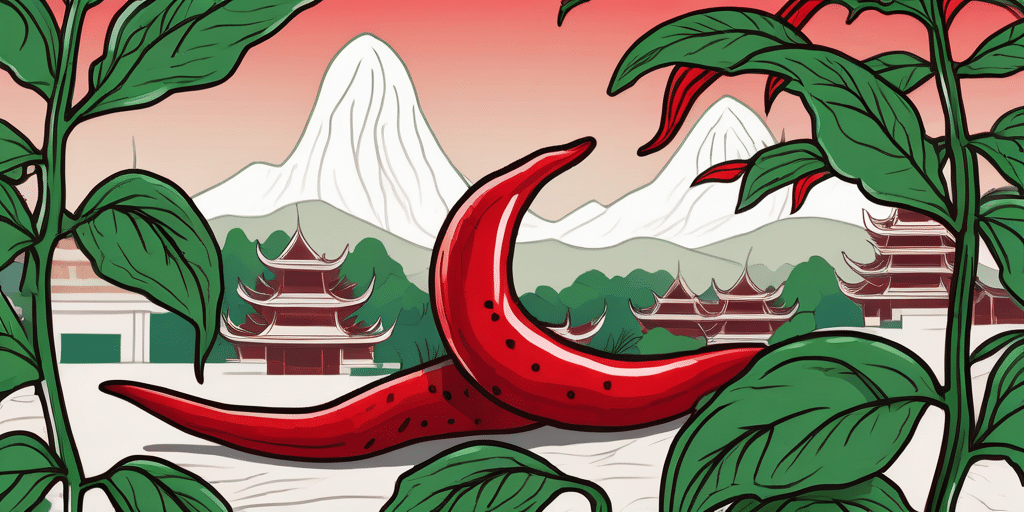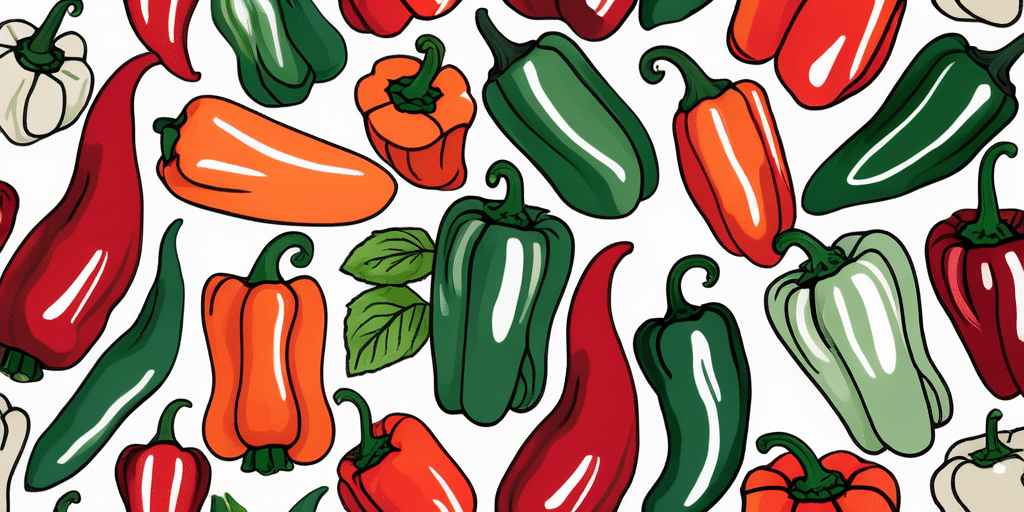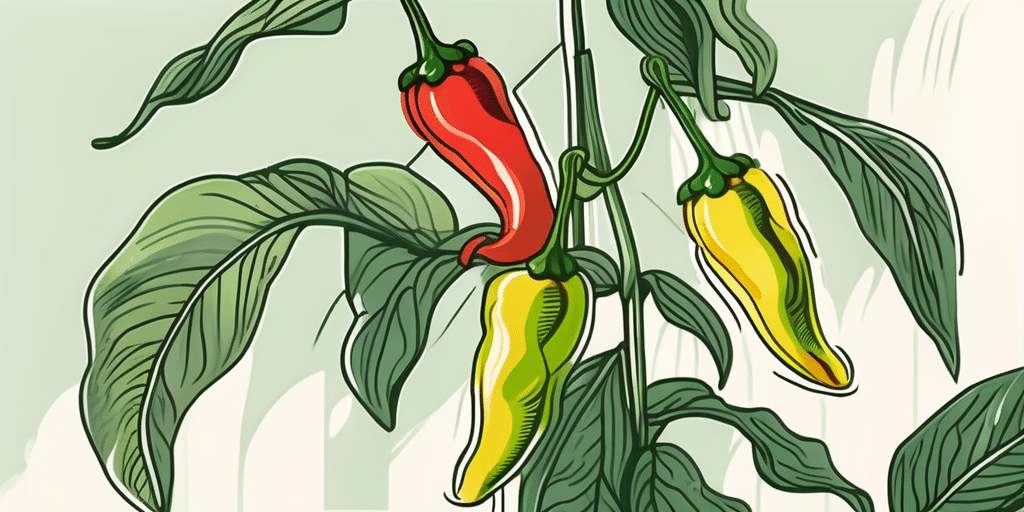Cherry Bomb peppers are vibrant and spicy, making them a favorite among chili lovers. Whether you’re a seasoned gardener or a beginner, you can easily grow these delicious peppers in your garden, indoors, or in containers. In this guide, we’ll take you through each step of the way to ensure a successful harvest. Let’s get started!
When to Start Cherry Bomb Peppers
The timing of starting your cherry bomb pepper seeds is crucial to ensure optimal growth. You should start your seeds indoors, 8-10 weeks before the last frost date in your area. This will give the pepper plants enough time to mature and produce fruit.
Cherry bomb peppers, known for their vibrant red color and spicy kick, thrive in warm climates with plenty of sunlight. They are a popular choice for home gardeners looking to add some heat to their dishes. When starting your cherry bomb pepper seeds indoors, make sure to use a well-draining seed starting mix to prevent waterlogging, which can lead to root rot.
Once your cherry bomb pepper seedlings have developed their second set of true leaves, they can be transplanted into larger containers or directly into the garden. Be sure to harden off your seedlings before transplanting them outside to acclimate them to the outdoor conditions gradually. Cherry bomb peppers are heavy feeders, so fertilize them regularly with a balanced fertilizer to support healthy growth and fruit production.
How to Grow Cherry Bomb Peppers From Seed
Growing cherry bomb peppers from seed is a rewarding experience. Here’s how you can do it:
- Fill a seed tray or small pots with a seed-starting mix.
- Plant the cherry bomb pepper seeds about 1/4 inch deep in the soil.
- Water the seeds gently to ensure the soil is moist but not waterlogged.
- Place the tray or pots in a warm location, such as near a window or under a grow light.
- Keep the soil consistently moist by watering as needed.
- Once the seedlings have grown their first true leaves, you can transplant them into larger pots or containers.
Expanding on this process, it’s important to note that cherry bomb peppers thrive in warm temperatures and require plenty of sunlight to grow successfully. If you’re starting your seeds indoors, consider using a heat mat to maintain a consistent temperature for germination. Additionally, providing adequate air circulation around the seedlings can help prevent issues like damping off, a fungal disease that can affect young plants.As your cherry bomb pepper plants continue to grow, you may need to support them with stakes or cages to prevent the heavy fruit-laden branches from breaking. Pruning can also help promote better air circulation and higher yields. Remember to fertilize your plants regularly with a balanced fertilizer to ensure they have the nutrients they need to produce healthy fruits.Once your cherry bomb peppers start to develop, you can harvest them when they reach their mature red color. These peppers are known for their medium heat level, making them a versatile choice for adding a spicy kick to various dishes. Enjoy the process of growing your own cherry bomb peppers and savor the flavorful results in your culinary creations!
How and When to Transplant Cherry Bomb Peppers
Transplanting your cherry bomb pepper seedlings is a crucial step in their growth journey. Here’s what you need to know:
- Wait until all danger of frost has passed before transplanting your pepper seedlings.
- Choose a sunny location in your garden with well-draining soil.
- Dig a hole that is slightly larger than the root ball of the seedling.
- Gently remove the seedling from its pot, taking care not to damage the roots.
- Place the seedling in the hole and backfill with soil, ensuring that the top of the root ball is level with the soil surface.
- Water the transplanted seedling thoroughly to help it establish in its new location.
Cherry bomb peppers, known for their vibrant red color and medium heat level, thrive in warm climates with plenty of sunlight. These peppers are a favorite among gardeners for their versatility in the kitchen, adding a spicy kick to various dishes like salsas, salads, and marinades. When transplanting cherry bomb pepper seedlings, it’s essential to consider their mature size, as these plants can grow to be around 2-3 feet tall and wide, requiring ample space to spread out.
In addition to proper planting techniques, cherry bomb peppers benefit from regular fertilization throughout the growing season. A balanced fertilizer high in phosphorus can promote healthy root development and abundant fruit production. Mulching around the base of the pepper plants can help retain moisture in the soil and suppress weed growth, ensuring that the plants receive the necessary nutrients without competition from other unwanted vegetation.
How to Plant Cherry Bomb Peppers – Spacing and Patterns
Proper spacing and planting patterns are essential for the optimal growth of cherry bomb peppers. Follow these guidelines when planting:
- Space your pepper plants about 18-24 inches apart to allow for adequate airflow and sunlight.
- Consider planting your cherry bomb peppers in rows, with about 24-36 inches between each row.
- If you’re growing peppers in containers or pots, choose a pot that is at least 12 inches in diameter for each plant.
Cherry bomb peppers, known for their vibrant red color and medium heat level, thrive in warm climates with plenty of sunlight. When selecting a location for planting, ensure that the area receives at least 6-8 hours of direct sunlight daily. This will help the plants produce healthy fruits and reach their full potential in terms of flavor and spice.
Additionally, cherry bomb peppers benefit from well-draining soil rich in organic matter. Before planting, amend the soil with compost or aged manure to provide essential nutrients for the peppers to grow. Maintaining soil pH around 6.0 to 6.8 is ideal for cherry bomb peppers, as it allows for optimal nutrient uptake and overall plant health.
How Long to Grow Cherry Bomb Peppers
Patience is key when it comes to growing cherry bomb peppers. On average, it takes about 70-80 days from transplanting for the peppers to reach maturity and be ready for harvest. However, this timeframe may vary depending on growing conditions and individual plant health.
Cherry bomb peppers, known for their vibrant red color and spicy kick, thrive in warm climates with plenty of sunlight. These peppers are typically planted in the spring after the last frost has passed, allowing them a long growing season to develop to their full potential. Adequate watering and well-draining soil are essential for the healthy growth of cherry bomb peppers, as they are sensitive to waterlogged roots.
As the cherry bomb peppers grow, they will progress through various stages, starting as small green fruits and gradually turning into the iconic red peppers that are ready for harvest. It’s important to monitor the plants for any signs of pests or diseases, as these can hinder the growth and development of the peppers. By providing proper care and attention throughout the growing process, you can ensure a bountiful harvest of delicious cherry bomb peppers to enjoy in your favorite dishes.
How to Water Cherry Bomb Peppers
Consistent watering is crucial for the healthy growth of cherry bomb peppers. Here are some tips for watering:
- Water your pepper plants deeply once a week, providing enough moisture to penetrate the root zone.
- Avoid overwatering, as it can lead to root rot and other plant diseases.
- Keep an eye on the weather conditions and adjust your watering schedule accordingly, allowing for natural rainfall.
Cherry bomb peppers, known for their vibrant red color and spicy flavor, thrive in well-draining soil that retains moisture without becoming waterlogged. When watering your cherry bomb peppers, it’s essential to water at the base of the plants to prevent wetting the foliage, which can invite fungal diseases. Additionally, using a soaker hose or drip irrigation system can help deliver water directly to the root zone, promoting healthy root development.
During periods of extreme heat or drought, cherry bomb peppers may require more frequent watering to prevent stress and ensure optimal fruit production. To check if your plants need water, simply insert your finger into the soil near the base of the plant. If the top inch of soil feels dry, it’s time to water. Remember, consistency is key when watering cherry bomb peppers to maintain steady growth and bountiful harvests.
How to Fertilize Cherry Bomb Peppers
Feeding your cherry bomb pepper plants with the right nutrients will ensure vigorous growth and abundant fruit production. Here’s what you need to know:
- Before planting, prepare the soil by incorporating organic matter, such as compost or well-rotted manure.
- Apply a balanced organic fertilizer, following the recommended dosage on the package.
- Side-dress the plants with a nitrogen-rich fertilizer, such as blood meal or fish emulsion, once they start flowering.
- Repeat the side-dressing every 4-6 weeks throughout the growing season.
Sunlight Requirements for Cherry Bomb Peppers
Cherry bomb peppers thrive in full sun, which means they need at least 6-8 hours of direct sunlight each day. Choose a location in your garden that receives ample sunlight to ensure healthy plant growth and abundant fruit production.
Soil Requirements for Cherry Bomb Peppers
Cherry bomb peppers prefer well-draining soil that is fertile and rich in organic matter. Here are some guidelines for preparing the soil:
- Test your soil’s pH level using a soil test kit, aiming for a range of 6.0-6.8, which is slightly acidic to neutral.
- Incorporate organic matter, such as compost, into the soil to improve its fertility and structure.
- Avoid heavy clay soils that can lead to waterlogging and hinder root development.
How to Grow Cherry Bomb Peppers Outdoors
Growing cherry bomb peppers outdoors is a great option if you have a sunny garden or backyard. Here’s what you need to know:
- Choose a location that receives full sun and has well-draining soil.
- Prepare the soil by incorporating organic matter and ensuring proper pH levels.
- Start your pepper seeds indoors, following the recommended timing for your area.
- Transplant the seedlings once all danger of frost has passed.
- Water and fertilize as needed and watch your plants thrive in the outdoor environment.
How to Grow Cherry Bomb Peppers Indoors
If you don’t have access to outdoor space or live in a cooler climate, growing cherry bomb peppers indoors is a fantastic option. Here’s what you need to do:
- Choose a container or pot that is at least 12 inches in diameter and has drainage holes.
- Fill the container with a well-draining potting mix.
- Plant your pepper seeds or transplant seedlings into the container.
- Place the container in a sunny location, such as near a south-facing window or under grow lights.
- Water the peppers regularly, ensuring that the soil remains consistently moist but not waterlogged.
- Fertilize the plants regularly to provide them with the necessary nutrients.
How to Grow Cherry Bomb Peppers In Containers and Pots
Growing cherry bomb peppers in containers and pots is a versatile option that allows you to enjoy fresh peppers even if you have limited space. Here’s what you need to know:
- Choose a container or pot that is at least 12 inches in diameter and has drainage holes.
- Fill the container with a well-draining potting mix.
- Plant one cherry bomb pepper plant per container.
- Place the containers in a sunny location, such as on a patio or balcony.
- Water the peppers regularly, ensuring that the soil remains consistently moist but not waterlogged.
- Fertilize the plants regularly to provide them with the necessary nutrients.
Cherry Bomb Peppers Companion Plants – What to Plant With & Not Plant With Cherry Bomb Peppers
Choosing the right companion plants for your cherry bomb peppers can help enhance their growth and deter pests. Here are some ideal companion plants:
- Basil: This aromatic herb repels aphids and adds a delightful flavor to your peppers.
- Marigolds: These vibrant flowers repel nematodes and other pests that can harm your peppers.
- Onions: These pungent bulbs deter pests and can be harvested alongside your peppers.
Avoid planting the following plants near your cherry bomb peppers:
- Fennel: Fennel can inhibit the growth of peppers, so it’s best to keep them apart.
- Brassicas: Plants in the brassica family, such as cabbage and broccoli, can attract pests that also target peppers.
By choosing the right companion plants, you can create a thriving and pest-resistant pepper garden.
Common Cherry Bomb Peppers Pests and Diseases
While cherry bomb peppers are generally hardy plants, they can be susceptible to certain pests and diseases. Here are some common issues to watch out for:
- Aphids: These small insects can suck the sap from your pepper plants, leading to stunted growth. Use insecticidal soap or neem oil to control them.
- Fruit Flies: Fruit flies can be a menace, especially as your peppers start to ripen. Set up traps or use organic fruit fly baits to keep them away.
- Blossom End Rot: This condition causes the bottoms of the peppers to darken and shrivel. It is often caused by calcium deficiency or irregular watering. Ensure consistent moisture levels and add calcium-rich amendments to the soil.
By monitoring your pepper plants regularly and taking appropriate action, you can keep these pests and diseases at bay.
How & When to Harvest Cherry Bomb Peppers
Knowing when and how to harvest your cherry bomb peppers is essential to ensure the best flavor and texture. Here’s what you need to know:
- Wait until the peppers have reached their mature color, which is bright red for cherry bomb peppers.
- Use a sharp pair of scissors or pruning shears to cut the peppers just above the stem.
- Harvest peppers when they are firm and glossy, indicating full ripeness.
How to Store & Preserve Cherry Bomb Peppers
To enjoy your cherry bomb peppers for longer, you can store and preserve them using various methods. Here are some options:
- Refrigeration: Keep your peppers in the refrigerator in a perforated plastic bag. They can stay fresh for up to two weeks.
- Freezing: Wash and dry your peppers, then chop or slice them before freezing in airtight containers or freezer bags. Frozen peppers can retain their flavor for up to a year.
- Preserving: Consider pickling your cherry bomb peppers for a tangy and spicy addition to sandwiches and salads. Follow a trusted pickling recipe for best results.
Choose the method that suits your preferences and enjoy the flavors of your garden all year round.
Frequently Asked Questions
To wrap up, here are answers to some commonly asked questions about growing cherry bomb peppers:
Q: Can I grow cherry bomb peppers from store-bought peppers?
A: While it’s possible to grow cherry bomb peppers from store-bought peppers, it’s more reliable to use seeds from reputable seed sources. Store-bought peppers may not be suited for growing due to hybridization or other factors.
Q: Can cherry bomb peppers grow in colder climates?
A: Cherry bomb peppers thrive in warm climates, but with proper care, they can be grown in colder regions as well. Consider starting your seeds indoors and using season-extending techniques, such as row covers or greenhouses.
Q: Are cherry bomb peppers spicy?
A: Yes, cherry bomb peppers are known for their spiciness. They have a Scoville heat unit (SHU) rating between 2,500-5,000, which puts them in the medium range of spiciness.
Q: Can I grow cherry bomb peppers in pots on my apartment balcony?
A: Absolutely! Cherry bomb peppers are well-suited for container gardening. Choose a larger pot, ensure proper drainage, and place your containers in a sunny location on your balcony.
By following these guidelines and providing your cherry bomb peppers with the care they need, you’ll be rewarded with a bountiful harvest of spicy and delicious peppers. Happy gardening!
Join Our Growing Community
Ready to turn up the heat in your garden with Cherry Bomb peppers? Subscribe for free to How to Grow Everything and let us guide you through creating the garden of your dreams. Receive personalized gardening advice tailored to your specific location, grow zone, and experience level. Our family is dedicated to helping yours succeed in gardening, with exclusive tips and special offers delivered straight to your inbox. Join thousands of others learning to grow everything, 100% free—because the best gardens start with the best knowledge.





